#historia Cypru
Explore tagged Tumblr posts
Text
Cypr odzyskał starożytne artefakty
Ponad 100 historycznych artefaktów, w tym ceramiczne amfory, monety i ikony, zostało zwróconych Cyprowi z Wielkiej Brytanii. Według Departamentu Starożytności artefakty zostały przekazane Wysokiej Komisji Cypryjskiej w Londynie przez brytyjską policję po ich odebraniu osobom, które były w ich posiadaniu. W kolekcji znajdują się kamienne narzędzia neolityczne datowane na VI i VII w. p.n.e.,…
0 notes
Note
I know that in most stories only Hermione exists but in some of the stories where Helen also has kids with Paris, what happens to them? What’s their outcome?
ps. I can’t imagine Helen wanting to have kids in the first place. She comes off as someone who didn’t want to have kids but had to. I kinda headcanon that although she learned to love Hermione, it was not this unconditional love that moms are supposed to feel and she felt very guilty over that
Mostly, we don't know what happens to them, because the sources are fragmentary!
Aganos Scholiast on Euripides, Andr. 898: The writer of the Cyprian Histories says that (Helen's third child was) Pleisthenes and that she took him with her to Cyprus, and that the child she bore Alexandrus was Aganus.
For some reason this fragment isn't in my edition of the Loeb that deals with Epic Cycle fragments, and neither has Martin West included it in The Epic Cycle: a Commentary on the Lost Troy Epics, as excellent as it otherwise is. It is however included in an earlier Loeb edition, and Malcolm Davies in his The Cypria (freely available on The Center for Hellenic Studies website) includes it as well. Maybe because it's a question of if "Cyprian Histories/Kypriakas historias" are assumed to be another work and not the same as the Kypria.
I think this is the only place Aganos is mentioned (unless he's one of the three children mentioned by John Malalas). If this fragment doesn't belong to the Kypria, Since we apparently can't be sure which work this detail belongs to, and thus not how old of an idea Aganos is, it's impossible to say if there was, in fact, some pre-Homeric and traditional idea to Helen and Paris having at least one child.
What's really interesting for this fragment is, of course, that presumably these two half-brothers grow up together. Why Helen would take a probably-infant son with her on a potentially dangerous journey, but leave Hermione (whatever her age), I have no idea. This is all we know of these two, so what their end was we don't have a clue.
(Pleisthenes' pre-war existence here is interesting to me, too, since it sort of hooks into the existence of these other children of Menelaos and Helen existing pre-war. Sophocles in his Electra (line 539ff) says Menelaos and Helen had two children by the point Paris came to Sparta, because he could/should then have sacrificed either of them instead of Klytaimnestra having to give up Iphigenia. I wonder which potential son is imagined - is it Pleisthenes again, who we by this fragment knows could be pre-war? Is it Nikostratos, though he's usually given as the youngest and post-war?)
Korythos, Bunomos and Idaios Dictys (probably written somewhere in the 50-100CE) is where these three are grouped as children of Helen and Paris, and Dictys also has these three children killed. It happens right after Paris' own death, where a roof collapses in on them (the characters believe it judgement/punishment by the gods, but as the gods are absent, even if the moralising idea is undoubtedly meant both by the characters and the author, it doesn't have divine backing in-story). Korythos is sometimes known as Helenos, too.
Even a little earlier than this Korythos can however be the son of Helen and Paris; Nicander around 100 BCE and forward wrote this: "There was the tomb of fallen Corythus, Whom Helen bare, the fruit of marriage-rape*, In bitter woe, the Herdsman’s evil brood." (*the Greek here is harpage-damazo-hymenaios, so Nicander is definitely presenting the Helen-Paris relationship as abduction and rape.)
John Malalas gives Helen and Paris three sons as well (because he's basing his Chronographia off of Dictys), but I don't think their deaths are actually mentioned.
Helen (Jr.) Her only existence is in Ptolemaeus Chennus, which means it is Highly Suspect since his work is probably a parody of a mythological handbook. But I don't want to skip her, for part of this is quite charming, honestly. Paris and Helen each want to name her after themselves and play knucklebones over the privilege, Helen wins. This Helen Jr. is then killed by Hecuba during the sack.
For your p.s.; yeah, I agree! From beginning to end haha, that it was a love that came with time, and that made Helen feel guilty (especially when Hermione was small). Helen being a slightly more involved mother when Hermione is older because they can interact more, on a more complex level, and thus that's where the bonding and affection really comes. (Or, for my version where I have Hermione still a toddler, would have come.) I vaguely have the headcanon that both Helen and Kytaimnestra actually had no great desire for children and found no great fount of maternal ability or fondness when they did, by duty, have them. (I think my feeling on Klytaimnestra is then that that's why she lavished so much on Iphigenia, as her oldest. She wasn't abusive before the sacrifice, just not the most present or maternal mother.)
8 notes
·
View notes
Text
The Caffè Florian opened in St Mark's Square, where it still stands today, on 29 December 1720. Important people have passed through this café, such as: Lord Byron, Vivaldi, Goethe, Rousseau, Stravinski... y también Casanova.
El Caffè Florian abrió sus puertas en la Plaza de San Marcos, donde sigue permaneciendo, el 29 de diciembre de 1720. Por este café han pasado personajes importantes, como: Lord Byron, Vivaldi, Goethe, Rousseau, Stravinski... y también Casanova.
Il Caffè Florian aprì in Piazza San Marco, dove si trova tuttora, il 29 dicembre 1720. In questo caffè sono passati personaggi importanti, come: Lord Byron, Vivaldi, Goethe, Rousseau, Stravinski… y también Casanova
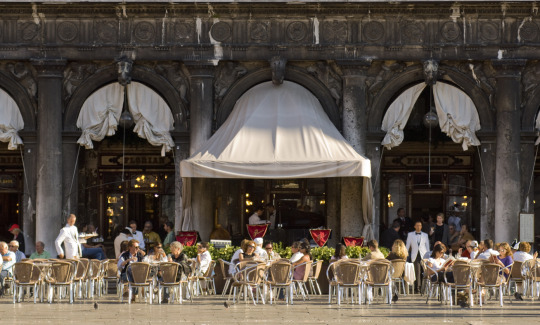
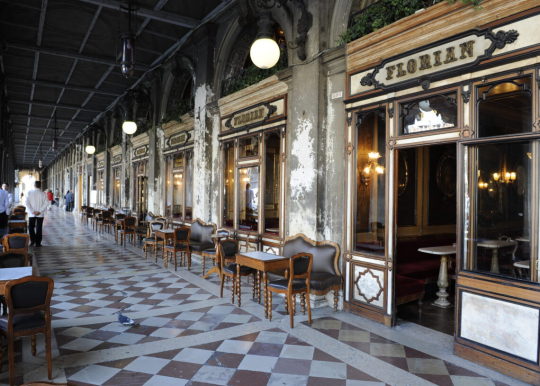
(English / Español / Italiano)
The Europe's oldest Café was opened on 29 December 1720 by Floriano Francesconi and was called "Alla Venezia Trionfante" (To Triumphant Venice), although the clientele later renamed it "Caffè Florian" in honour of its owner.
While the finest wines and coffees from the Orient, Malaysia, Cyprus and Greece were served, history was unfolding outside. Its windows witnessed the splendour and fall of the Serenissima Republic of Venice and the secret conspiracies against French and then Austrian rule. It is divided into small rooms connected by a corridor and has a huge terrace on St. Mark's Square for sunny days. The rooms are decorated in different styles;
*****
El Café más antiguo de Europa fue inaugurado el 29 de diciembre de 1720 por Floriano Francesconi y se llamaba “Alla Venezia Trionfante” (A la triunfante Venecia), aunque la clientela posteriormente lo rebautizó como “Caffè Florian” en honor a su dueño.
Mientras se servían los mejores vinos y cafés de Oriente, Malasia, Chipre y Grecia, la historia se desarrollaba afuera. Sus ventanas presenciaron el esplendor y la caída de la República Serenissima de Venecia y las conspiraciones secretas contra el dominio francés y luego el austriaco. Se encuentra distribuido en pequeñas salas unidas todos ellas, por un corredor y además, tiene una enorme terraza en la plaza San Marcos para los días soleados. Las salas están decoradas en distintos estilos.
*****
Il Caffè più antico d'Europa fu aperto il 29 dicembre 1720 da Floriano Francesconi e si chiamava "Alla Venezia Trionfante", anche se poi la clientela lo ribattezzò "Caffè Florian" in onore del suo proprietario.
Mentre venivano serviti i migliori vini e caffè provenienti dall'Oriente, dalla Malesia, da Cipro e dalla Grecia, all'esterno si svolgeva la storia: le sue finestre sono state testimoni dello splendore e della caduta della Serenissima Repubblica di Venezia e delle cospirazioni segrete contro il dominio francese e poi austriaco. È diviso in piccole sale collegate da un corridoio e dispone di un'enorme terrazza su Piazza San Marco per le giornate di sole. Le sale sono arredate in stili diversi.
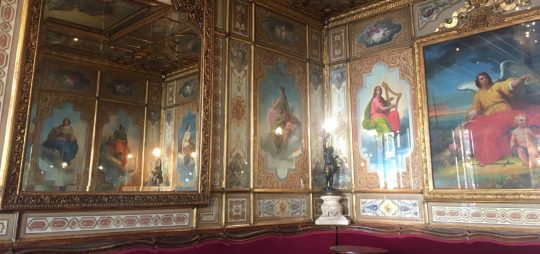
The Senate Hall. This is where the Venice Biennale was born.
La Sala del Senado. En ella nació la Bienal de Venecia.
La Sala del Senato. Qui è nata la Biennale di Venezia.
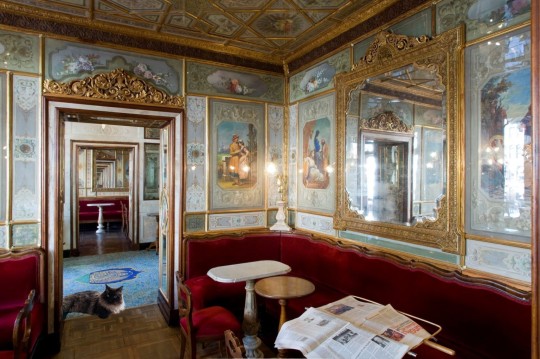
The Chinese room, the oldest and one of the two initial rooms.
La Sala China, la más antigua y una de las dos iniciales.
La Sala Cinese, la più antica e una delle due sale iniziali.
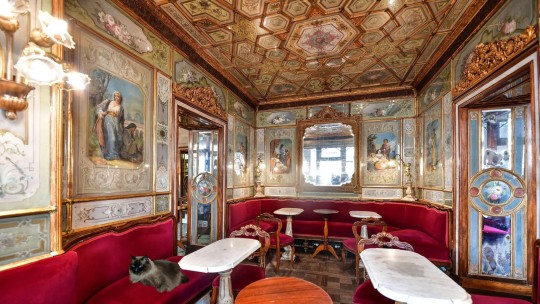
The Sala Orientale, added in 1750, although the present decoration dates from the 19th century.
La Sala Orientale, agregada en 1750, aunque la decoración actual es de s.XIX.
La Sala Orientale, aggiunta nel 1750, anche se la decorazione attuale risale al XIX secolo.
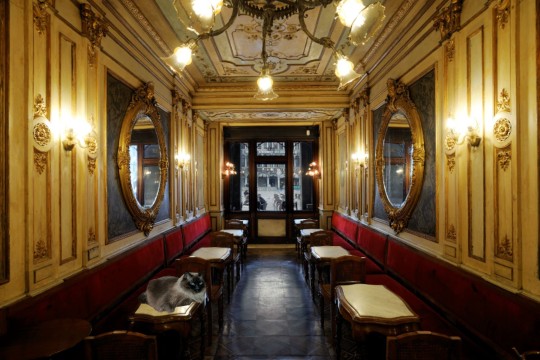
Hall of the Seasons, decorated with floral motifs and women in long dresses symbolising the seasons.
Sala de las Estaciones, decorada con motivos florales y mujeres de largos vestidos que simbolizan las estaciones.
Sala delle Stagioni, decorata con motivi floreali e donne in abiti lunghi che simboleggiano le stagioni.
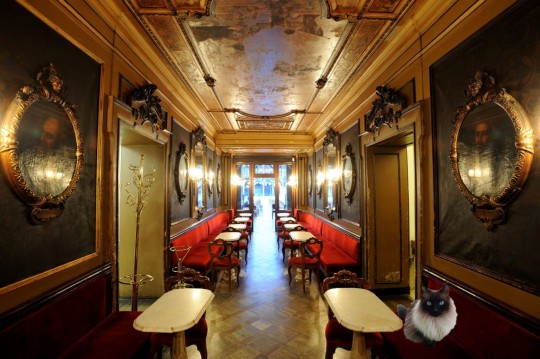
The Hall of Illustrious Men, ten illustrious Venetians, such as Titian and Marco Polo, look down on us from the wall.
La Sala de los Hombres Ilustres, diez venecianos ilustres nos observan desde la pared, como Tiziano o Marco Polo.
La Sala degli Uomini Illustri, dieci illustri veneziani, come Tiziano e Marco Polo, ci guardano dal muro.
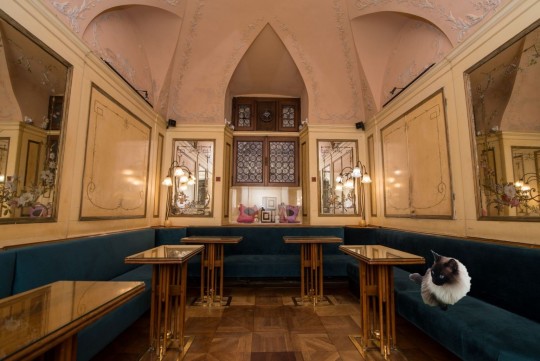
The Liberty room, added, in 1920, with a more modern atmosphere, decorated with mirrors with painted floral motifs and Murano glass chandeliers.
La Sala de la Liberty, agregada, en 1920, con un ambiente más moderno, decorada con espejos con motivos florales pintados y lámparas de cristal de Murano.
Nel 1920 è stata aggiunta la Sala Liberty, con un'atmosfera più moderna, decorata con specchi con motivi floreali dipinti e lampadari in vetro di Murano.
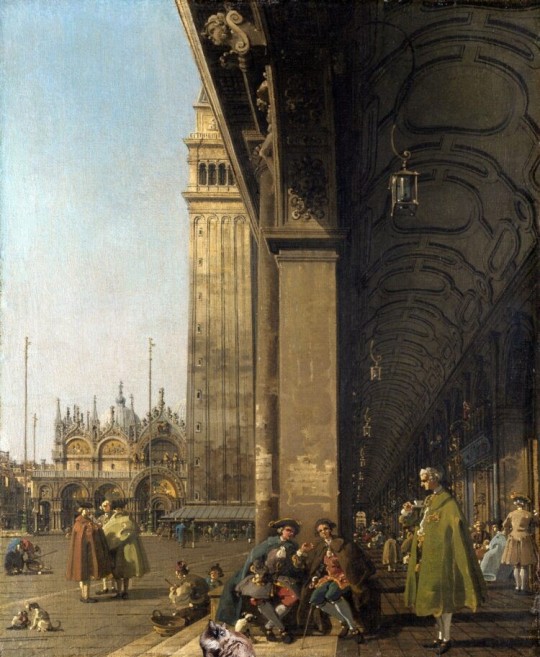
The Caffè Florian in a painting by Canaletto in the National Gallery in London.
The Florian was the first place that allowed women in Venice, which explains why Casanova chose it for the hunt for his conquests.
El Florian fue el primer local que permitió la entrada a mujeres en Venecia, lo que explica porqué Casanova lo eligió para la caza de sus conquistas.
Il Florian fu il primo locale che permise alle donne di entrare a Venezia, il che spiega perché Casanova lo scelse per la caccia alle sue conquiste.
Fuente: texto extracto de venecisima.com
#venezia#venice#venecia#piazza san marco#s.XVIII#18th century#florian cafe#lord byron#vivaldi#stravinsky#rousseau#goethe#casanova#st mark's square
13 notes
·
View notes
Text
THE MOTHER GODDESS OF THE MEDITERRANEAN
LA DIOSA MADRE DEL MEDITERRANEO
LA DEA MADRE DEL MEDITERRANEO

(english / Español / Italiano)
Statuette of the Mother goddess of the Mediterranean, found in Senorbì, Sardinia. It belongs to the Ozieri culture (San Michele culture) which lived on the island between 3200 and 2800 BC. It takes its name from the locality where the main finds related to it were found, the grotto of San Michele near Ozieri, in northern Sardinia, Italy.
The culture's influence also extended to nearby Corsica and Malta, where statuettes of goddesses similar to those of the Ozieri culture have been found. Religion included the worship of the Neolithic Mother goddess and a Bull god, perhaps related to fertility. The cruciform shape is reminiscent of Cyprus figurines.
----------------------------------------------------------------------------
Estatuilla de la diosa Madre del Mediterráneo, encontrada en Senorbì, Cerdeña. Pertenece a la cultura Ozieri (cultura San Michele) que vivió en la isla entre el 3200 y el 2800 a.C. Toma su nombre de la localidad donde se encontraron los principales hallazgos relacionados con ella, la gruta de San Michele cerca de Ozieri, en el norte de Cerdeña, Italia.
La influencia de la cultura se extendió también a las cercanas Córcega y Malta, donde se han encontrado estatuillas de diosas similares a las de la cultura Ozieri. La religión incluía la adoración de la diosa Madre neolítica y de un dios Toro, quizás relacionado con la fertilidad. La forma cruciforme recuerda a las figurillas de Chipre.
-----------------------------------------------------------------------------
Statuetta della dea Madre del Mediterraneo, rinvenuta a Senorbì, in Sardegna. Appartiene alla cultura di Ozieri (cultura di San Michele), vissuta sull'isola tra il 3200 e il 2800 a.C. Prende il nome dalla località in cui sono stati rinvenuti i principali reperti ad essa collegati, la grotta di San Michele presso Ozieri, nel nord della Sardegna, Italia.
L'influenza di questa cultura si estese anche alla vicina Corsica e a Malta, dove sono state trovate statuette di dee simili a quelle della cultura di Ozieri. La religione comprendeva il culto della dea madre neolitica e di un dio toro, forse legato alla fertilità. La forma cruciforme ricorda le statuette cipriote.
Fuente: Diario de Historia
#prehistory#prehistoria#neolithic#neolitico#cultura ozieri#madre del mediterraneo#Mother goddess of the Mediterranean#culto della dea madre#culto de la diosa Madre#mother goddess cult#ozieri
0 notes
Text
Jakie są szanse na zwycięstwo Cypru w konkursie Eurowizji?
🎰🎲✨ Darmowe 2,250 złotych i 200 darmowych spinów kliknij! ✨🎲🎰
Jakie są szanse na zwycięstwo Cypru w konkursie Eurowizji?
Cypr brał udział w Konkursie Piosenki Eurowizji już od 1981 roku. Pierwszym utworem reprezentującym Cypr był "Monika" w wykonaniu Island Duo. Kraj ten od tego czasu regularnie bierze udział w konkursie, często prezentując energetyczne i taneczne piosenki.
W historii uczestnictwa Cypru w Eurowizji warto wspomnieć o sukcesach, jakie udało się osiągnąć. W 2004 roku zespół Oniro zdobył trzecie miejsce z piosenką "Stronger Every Minute", co było największym osiągnięciem Cypru do tamtej pory. Kolejne dobre wyniki to m.in. czwarte miejsce w 1997 roku i piąte miejsce w 1999 roku.
Cypr często prezentuje piosenki w języku angielskim, co pomaga w przyciągnięciu międzynarodowej publiczności. Artystyczne występy, barwne kostiumy i interesujące choreografie sprawiają, że reprezentacje Cypru zawsze przyciągają uwagę podczas konkursu.
Mimo sukcesów, Cypr nie zawsze radzi sobie tak dobrze w Konkursie Piosenki Eurowizji. W niektórych latach kraj ten nie zakwalifikował się do finału, co zdarzyło się np. w 2014 roku. Niemniej jednak, udział w konkursie jest dla Cypru ważnym wydarzeniem kulturalnym, które pozwala mu zaprezentować się przed publicznością z całej Europy.
Podsumowując, historia uczestnictwa Cypru w Eurowizji jest pełna różnorodnych piosenek, artystycznych występów i emocjonujących momentów. Kraj ten zawsze stara się zaprezentować się jak najlepiej i zdobyć sympatię widzów z całego kontynentu.
Na przestrzeni lat Cypr brał udział w konkursie piosenki Eurowizji, odnosząc zarówno sukcesy, jak i niepowodzenia. Jednym z największych sukcesów kraju było zajęcie piątego miejsca w 2004 roku. Zespół Lisa Andreas zaśpiewał wtedy utwór "Stronger Every Minute", który zdobył uznanie zarówno widzów, jak i jury. Kolejnym udanym występem było drugie miejsce w 2018 roku, kiedy to Eleni Foureira zaśpiewała przebojową piosenkę "Fuego", która zdobyła popularność nie tylko w Europie, ale i na całym świecie.
Mimo sukcesów, Cypr doświadczył również porażek na Eurowizji. W niektórych latach reprezentanci kraju nie zakwalifikowali się do finału, co było dla nich rozczarowaniem. Ponadto, nawet gdy udawali się do finału, nie zawsze osiągali wysokie miejsca. Należy pamiętać, że konkurs Eurowizji jest bardzo konkurencyjny, a preferencje widzów i jury mogą być różnorodne.
Wnioski z udziału Cypru na Eurowizji są różnorodne. Pokazują, że sukces nie jest gwarantowany, nawet jeśli występ jest starannie przygotowany. Jednakże wysoka jakość wykonania, oryginalność piosenki i przekaz emocjonalny mają kluczowe znaczenie dla osiągnięcia dobrego wyniku. Bez względu na wynik, udział w Eurowizji daje artystom szansę zaprezentowania swojego talentu szerokiej publiczności i zdobycia międzynarodowej sławy.
Styl muzyczny reprezentacji Cypru jest jednym z najbardziej charakterystycznych i unikatowych w całej Europie. Cypr, będący krajem o bogatej historii kulturowej, odzwierciedla swój muzyczny dziedzictwo poprzez wyjątkowe brzmienia i rytm, które emanują z ich reprezentacji muzycznej.
Połączenie tradycyjnych dźwięków z nowoczesnymi rytmami Reprezentacja Cypru słynie z łączenia tradycyjnych instrumentów muzycznych, takich jak bouzouki czy lira, z nowoczesnymi brzmieniami i rytmami. Ta unikalna mieszanka daje wyjątkowy charakter ich muzyce i sprawia, że jest ona rozpoznawalna na całym świecie.
Inspiracje z muzyki wschodniej i zachodniej Cypr, będący położony na skrzyżowaniu Europy, Azji i Afryki, czerpie inspiracje z różnych kultur muzycznych. Ich styl reprezentacyjny odzwierciedla tę różnorodność, łącząc elementy muzyki wschodniej i zachodniej w unikatowy sposób.
Energetyczne i taneczne brzmienia Muzyka reprezentacji Cypru jest pełna energetycznych i tanecznych brzmień, które nie pozwalają nikomu stać w miejscu. Ich melodie są pełne życia i radości, co sprawia, że słuchacz nie może się oprzeć impulsowi, aby ruszyć biodrami w rytm muzyki.
Podsumowując, muzyczny styl reprezentacji Cypru to połączenie tradycji, nowoczesności i różnorodności, które tworzą niepowtarzalne brzmienie. Bez wątpienia muzyka cypryjska jest ważnym elementem ich kultury i dziedzictwa, które warto poznać i docenić.
W Małej Europie znajduje się mała wyspa o nazwie Cypr, która może nie należy do największych państw, ale z pewnością potrafi zaskoczyć swoimi talentami muzycznymi. Konkursy muzyczne, takie jak Eurowizja, są doskonałą okazją dla artystów z Cypru, aby zaprezentować swoje umiejętności na światowej scenie.
Składy konkursowe reprezentujące Cypr często charakteryzują się energetycznymi występami i nowoczesnym brzmieniem. W ostatnich latach kraje zaczęły inwestować w produkcję muzyczną i scenografie, co przyczyniło się do zwiększenia popularności cypryjskich występów na arenie międzynarodowej.
Cypr ma bogatą historię muzyczną, która często inspirowana jest tradycyjnymi dźwiękami kraju. Składy konkursowe reprezentujące ten klimatyczny kraj często nawiązują do lokalnych brzmień i kultury, co sprawia, że ich występy są wyjątkowe i niezapomniane.
Dzięki udziałowi w konkursach muzycznych składy reprezentujące Cypr mają okazję dotrzeć do szerokiej publiczności i zyskać uznanie za swoje talent. Mimo że wyspa ma niewielką populację, to muzycy z Cypru potrafią przyciągnąć uwagę swoją pasją do muzyki i charyzmą sceniczną.
Wielu artystów z Cypru po udziale w konkursach muzycznych zdobyło rozgłos na całym świecie i zyskało grono fanów. Dzięki wyjątkowym brzmieniom, energetycznym występom i charyzmatycznym wykonawcom składy konkursowe reprezentujące Cypr zasługują na uznanie i wsparcie ze strony fanów muzyki z całego świata.
Oczekiwania wobec występu Cypru na Eurowizji są zawsze wysokie, ponieważ kraj ten słynie z wysokiej jakości i energetycznych występów. Na Eurowizji, Cypr prezentuje często przebojowe piosenki w rytmicznych aranżacjach, które świetnie sprawdzają się na tle konkurencji. Fani muzyki z całej Europy często z niecierpliwością czekają na to, co Cypr przygotuje podczas corocznego konkursu.
Kraje biorące udział w Eurowizji starają się zaskoczyć i zachwycić publiczność, dlatego oczekuje się, że Cypr również postawi na oryginalność i wysoki poziom artystyczny. Choć nie zawsze udaje im się zająć pierwsze miejsca, ich występy zawsze są pełne energii i profesjonalizmu.
W tegorocznym występie Cypru na Eurowizji można spodziewać się interesującej choreografii, efektownych kostiumów i oczywiście wyjątkowego wokalu. Cypr często stawia na młodych i utalentowanych wykonawców, którzy potrafią porwać publiczność swoim występem.
Oczekiwania względem występu Cypru na Eurowizji są więc bardzo wysokie, ale jak pokazuje historia, kraj ten potrafi zaskoczyć i zrobić wielkie wrażenie na widzach. Nie pozostaje więc nic innego, jak czekać z niecierpliwością na to, co przygotuje Cypr w tegorocznej edycji konkursu. Jesteśmy pewni, że ich performance będzie dynamiczny, pełen emocji i niezapomniany dla wszystkich fanów Eurowizji.
0 notes
Text
Algo que has dicho
Decir que una chica fue asesinada por Artemisa equivale generalmente a que ella murió a dar a luz a un bebé, ya que la diosa es protectora de los partos, historia que es reflejada en ocasiones como la causa de muerte de Ariadna
Plutarch, Life of Theseus 20. 1 (trans. Perrin) (Greek historian C1st to C2nd A.D.) :
"Paion (Paeon) the Amathusian says that Theseus, driven out of his course by a storm to Kypros (Cyprus), and having with him Ariadne, who was big with child and in sore sickness and distress from the tossing of the sea, set her on shore alone, but that he himself, while trying to succour the ship, was borne out to sea again. The women of the island, accordingly, took Ariadne into their care . . . and gave her burial when she died before her child was born . . .
Quien siempre aparece en el arte aconsejando a Teseo para abandonar a Ariadna es Atenea la cual a veces solo quiere complacer a su hermano Dionisios para que se quede con Ariadna y otras veces porque no quiere que su ciudad Atenas de la cual es patrona tenga a Ariadna como reina, no por ser una princesa extranjera ya que Teseo tiempo después se casó con la hermana de Ariadna ,Fedra la cual fue muy bien recibida como reina(lo de Hipólito es tiempo después) sino porque Ariadna para ayudar a que Teseo derrotara al minotauro tuvo que traicionar a su padre quien era su rey y por lo tanto a su nación, situación parecida a la historia de Escila hija del rey Niso de Mégara. Así que los atenienses no iban a ver con buenos ojos que su rey se casara con una hija desleal ya que si alguien fue capaz de traicionar a su patria y llenar de vergüenza a la familia donde nació ,¿ que sería capaz de hacer contra aquellos que no compartía un vínculo sanguíneo y contra un país donde no había nacido?
You know too many people romanticize Hades and Persephone without any thought on what The Hymn to Demeter was actually about.
While I actually do think about Dionysus and Ariadne a fair bit as a rather romantic story for the Greeks. Of course, many versions of the orders of events, as is natural for such a long spanning mythic story.
But the idea that after Ariadne throws her whole life as a Princess away to guide Theseus through the labyrinth, saving all future sacrifices and allowing the death of her monster half brother, he abandons her on an island to die and Dionysus stumbles on her.
They fall in love, enough so that she ascends to Godhood with him. Enough so that in stories where she dies a mortal death he goes into the afterlife and pulls her back to him. Enough so there are versions where they raise their children on their vineyards. Enough so that every archaeological finding of them, from vases to funeral beds- when they aren’t in their separate stories- is them dining and drinking together and partying happily. Ariadne lost everything and then gained reverly and a full life afterwards.
636 notes
·
View notes
Photo
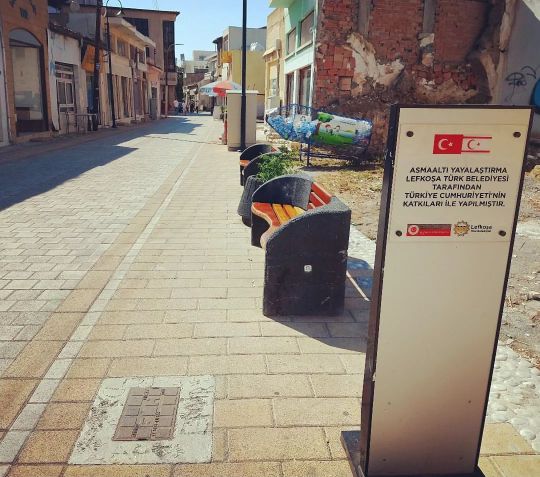
Nicósia (do Norte), capital da autoproclamada "República Turca do Chipre do Norte", um país não reconhecido por ninguém além da Turquia. . O exército turco ocupa a região desde a década de 70. . A ONU segue no local há mais de 40 anos garantindo a segurança, no espaço chamado de "Linha Verde", território neutro entre o Chipre grego (parte sul da ilha e maioria do território) e a parte turca (norte). ➖➖➖➖➖➖➖➖➖➖➖➖➖➖➖ Site: www.embarcando.com Siga @embarcandocom ➖➖➖➖➖➖➖➖➖➖➖➖➖➖➖ #embarcando #cyprus #northcyprus #europa #eurotrip #europe #chipre #nicosia #travelinspiration #historia #history #trip #travellife #travelphotography #travel (em Lefkoşa) https://www.instagram.com/p/CZ0edMkOdcc/?utm_medium=tumblr
#embarcando#cyprus#northcyprus#europa#eurotrip#europe#chipre#nicosia#travelinspiration#historia#history#trip#travellife#travelphotography#travel
2 notes
·
View notes
Quote
Eleni Foureira with "Fuego" achieves the best result in Cyprus Eurovision history (2).
Eurovision 2018.
#eurovision#ieeehrovision#eurovision 2018#esc#esc 2018#chipre#cyprus#history#historia#best result#mejor resultado#eleni foureira#fuego#sats#estadisticas
71 notes
·
View notes
Photo


The Pyrausta [Cypriot folklore; Roman folklore]
Cyprus is a country of copper mines, beautiful Roman and Neolithic settlements, and if Plinius is to be believed, tiny butterfly dragons. These mythical critters, called the Pyrausta or Pyrallis, resemble tiny dragons or lizards but with filmy insect wings. They have four legs, unlike insects (although some artists draw them with six legs). Often depicted with butterfly wings, some artists show them with dragonfly wings. Plinius major, whose ancient encyclopedia are always a joy to browse through, wrote an entry on these fluttering dragons. He claimed that these critters are small four-footed winged creatures, about as big as a large fly. Plinius never actually mentioned dragon-like characteristics or insect wings for this animal, but that’s the way the Pyrausta became popular with artists.
Supposedly, they spend their lives in burning flames, like a salamander - the mythical ones, not real salamanders. You see, Mediterranean salamanders have a tendency to hide in holes in firewood and flee when their logs are thrown into a fire. In ancient times, people often witnessed the little amphibians running out of an open fireplace and it was eventually thought that salamanders were born from flames.
The Pyrausta was thought to be a variant of this creature. If it spends too much time away from open flames, it will die. Plinius also claimed these creatures were ‘produced’ by the fire, implying they don’t have a conventional method of reproduction.
Source: The Naturalis Historiae by Plinius Maior (Book 11, 42nd chapter) (Image source 1: jefeazero on Deviantart) (Image source 2: StargazerRJL on Deviantart)
57 notes
·
View notes
Note
Okay, okay, okay, but holiday destinations for the AOT team...
I think Levi would love my country the UK for the tea we have here, but also maybe China or Japan. I can see him doing a tea country run, but he'd stay in very nice hotels with you because he needs things to be clean.
Hange I could see loving Scotland in the UK or Greece because of the history in both places. They'd freak out about the place and want to have battles.
Mike would for Germany, Norway, Finland etc somewhere he can drink good beer and eat meat.
Erwin gives me history vibes, so Italy or Greece for the development history and he'd love the cool battle plans that the Greeks and Romans did. Mostly Cyprus because of the battles there.
What do you think? What about the others?
Wow I did not mean to leave you hanging! I'm sorry and I love you <3
I'm also not as good at these HC as some of the rest of you but here it goes!
Levi - I looked up countries that serve the best tea, those were all up there! Sri Lanka and some others I wouldn't have though of are up there too. There are tea tours you know!
Erwin - Italy sounds right. Rome maybe, to see The Colosseum, or The Pantheon.
Hange - Them in Scotland, I can imagine how excited everything would get them. I bet they'd ask people to say something else just to hear the accent. And once they hear about the Loch Ness? They have to find out!
Miche - Oktoberfest in Munich. He's having the time of his life! Is out and about for at least one entire week of the festivities!
Eren - I just think Brazil for some reason. The beaches and the yearly festival held in Ipanema sound right up his alley. Also, Soccer fan?
Mikasa - goes where Eren goes no, China perhaps? Maybe Beijing and The Summer Palace or walking the Great Wall, or Shanghai and shopping at Nanjing Road.
Armin - Like the blonde commander before him, I think he'd like Italy as well. Specifically Vatican City and seeing the Sistine Chapel. Or maybe Venice with all the waterways.
Jean - I'm sticking with France here. He'd probably try to learn more about cooking and expand his skills. Maybe goes to the film festival, flirts with the ladies, asks if he can paint there picture.
Sasha - The country/continent of Australia! Visits the Great Barrier Reef and goes surfing at Bondi Beach. Tastes kangaroo meat for the first time. (no one shoot the vegetarian plz!)
Connie - possibly tags along to Australia and uses the lingo all the time. Or, maybe South America? Uruguay I'm thinking. Again, soccer fan, beaches, trying asado, really enjoying the culture.
Historia - Braves Sweden in Winter. Sees the Northern Lights, sleeps in an ice hotel, is thriving in the cold! Ymir of course goes too!
#eliza answers#very late and i'm so sorry#moots#moots jelly#aot#attack on titan#aot headcanons#attack on titan headcanons#i really tried here#would love to go to shanghai wiki mikasa#australia and italy too#eren and connie being hardcore soccer fans#i love it#i'd follow levi on the tea tour#and jean up the eiffel tower#these all sound fun lets go!
17 notes
·
View notes
Text
Kiedyś na Cyprze żyły słonie i hipopotamy
Cypryjczycy z epoki kamienia łupanego mogli doprowadzić do wyginięcia hipopotamów karłowatych i słoni Według badania opublikowanego w The Conversation , pierwsi osadnicy na Cyprze mogli być odpowiedzialni za wyginięcie charakterystycznych dla wyspy karłowatych hipopotamów i słoni, co podważa wcześniejsze założenia dotyczące chronologii przybycia człowieka i jego wpływu na lokalną…
0 notes
Text
Some New Reality!Au Headcanons
Been a while I have written some of these
-The AOT cast and a couple of anime characters and other characters starred in the Hetalia series.
Axis:
Italy/Romano: Eren
Germany/ HRE: Erwin replaced by Goku
Japan: Zoro
Allies:
America: Edward Elric
Canada: Alphonse Elric
France: Sanji
England: Bakugou
Russia: Zeke
China: Yato
Others:
Europe:
Belarus: Ymir (blonde Ymir) (Serves as Nyo! France)
Hungary: Annie (Nyo! England) replaced by Asuna
Austria: Sebastian
Belgium: Sasha
Luxembourg: Armin replaced by Kurapika
Netherlands: Porco replaced by Natsu
Czechia: Erza
Slovakia: Ichigo
Liechtenstein: Lucy Heartfilia ( Also Nyo!Luxembourg)
Poland: Naruto
Prussia: Jean
Ukraine: Shiemi Moriyama
Estonia: Urahara
Lithuania: Yukio
Denmark: Laxus
Finland: Meliodas
Iceland: Kaneki
Norway: Shizuo Heiwajima
Sweden: Reiner
Greece: Suzaku
Cyprus: Lelouch
Monaco: Historia
Spain/Portugal:
Turkey: Rin Okumura (suprisingly)
Africa:
Egypt: Yami Yugi
Seychelles: Canary (Hunter x Hunter)
Asia:
Hong Kong: Sousuke Sagara
Malaysia: Yuuki Kuran (also Nyo! Italy)
Phillipines: Light Yagami
Taiwan: Ahri (she also plays Nyo!Korea)
South Korea: Suzaku again
Macau: Aizen
Thailand: Ichigo
India: Haruhi Fujioka
Vietnam: Sakura Haruno (Nyo! Portugal and Spain)
Australia/ New Zealand: All Might
Cuba: Endevour
Seborga: Sasori
Others:
Ancient Rome: Grisha (xD)
Ancient Greece: Carla
Ancient Egypt: Yoruichi
Germania: Minato Namikaze
-The cast is huge and as a result, things get a little chaotic on set
- Eren happily took his role as he sees it as a challenge considering the fact that Italy is well.....a pretty cowardly pasta loving dude.
- Italy's high pitched voice was hard for Eren at first but eventually he nailed it and almost lost his voice in the process
-Eren uses his normal voice for Romano
-Eren also sang most of the Hetalia themes and everyone else sang their own versions of the songs including the character songs
- Majority of the cast changed their hairstyles to fit with their characters
-They all took language and accent classes to nail the accents of their respective characters. Hilarity ensued
- Rin and Sukazu in particular shocked everyone with their acting chops on the show and their characters became the darkhorses of the show
- Ymir scared everyone with her performance as Belarus xD
- Levi was the one that originally played Japan
- Eren and Levi broke up around the timing of Season 3 of Attack on Titan which aired around the same time as this show and maintained a certain level of animosity for each other for years after that. What caused the breakup is still a mystery and it is something neither party wants to talk about.
- Thanks to said breakup, Eren and Levi refused to shoot scenes together and they often used stand-ins whenever the two shot scenes together. They even refused to do fan events together until a recent Hetalia reunion forced them to do so. Needless to say, it was uncomfortable for Eren as Levi kept on shading him. Thankfully, the others called him out on it, leading to Levi leaving the show and getting replaced by Zoro who many believed to be a better fit for the role
- It was during this period that the relationship between Eren and Ahri deepened. Ironically some fans began to ship Italy and Taiwan due to that one scene where Italy takes Taiwan out on a date. That scene is both Eren and Ahri's favorite scene
- Speaking of the Royal Couple, the paparazzi caught Eren and Ahri kissing one day on set. That drove the media frenzy to an overdrive.
- Ironically, Eren and Ahri sort of dated in real life but had to seperate out of fear of the impact the constant media attention could cause to their relationship. They would get back together years later
- They always throw parties for their birthdays and big wrap parties after shooting for each season as well.
- The Asian kids are the main noisemakers on set
- Levi once played a deadly prank on Eren by firing a firework which hit and injured Eren and landed him in hospital for weeks. He has not apologised for that
- There have been jokes about France's ecchi tendencies amongst the cast, something Sanjii relishes with glee.
- Sanji and Bakogou actually get along in real life compared to their characters
- South Korea was initially edited out of the show due to some political controversy but was later restored back after fans demanded for his return. Suzaku was pleased with this
-The Nordics are as close as their characters and often go bungee jumping snowboarding together
- The Axis and Allies often engage in prank wars on set which often get out of hand
- Mikasa was offered the role of Taiwan initially but because she asked for way more money than she was supposed to be paid plus insisted on being the lead actress, the role was given to Ahri instead who made her acting debut through the show. Needless to say, Mikasa was not amused by this as the show made Ahri a big star especially as her character started getting more prominent on the show
- That incident started a one-sided rivalry of sorts between Ahri and Mikasa partially due to the show. The other reason is because of Eren
- It was during season 2 of Hetalia that Eren and the AOT cast regained their memories
- That alone caused a rift between the Hetalia cast and some of the AOT cast due to the manner by which Eren was treated. Those AOT cast members got replaced
- Jean, Reiner, Historia, Floch and Sasha are the only members of the AOT cast that still talk to Eren besides Zeke and Ymir and Eren's parents
- Eren's mental state began to decline during this period. The only thing that sort of kept him happy was Ahri who was unaware of what was going on because Eren did not tell her much. She would later find out in Lost And Found
- Season 4 of Attack on Titan was hellish for Eren given his actions in real life. The cast had to pretend like they were one happy family for the cameras when in reality that was never the case. Levi even lied and said that Eren cheated on him and even Mikasa when they dated whereas that was not true.
- Levi also told all sorts of ugly lies about Eren which caused a backlash on Eren for a while and almost led him to commit suicide
- Most of Eren's friends called Levi out on his actions and also dragged Mikasa down too for her own actions since she was part of the whole drama
- Eren has since semi-retired from the entertainment industry. He still performs to some extent and still records music but he has yet to release an album in years.
-There was a song Eren recorded about the Ackermans where he lambasted them for their actions called Toxic Love. He never released it but Zeke leaked it out anyways and fans were saddened that said song was not officially released as it would have been the perfect response to Levi's song, Blood Traitor
- Lelouch had a nasty breakup during this period as well from his girlfriend named Sally
- Eren was not the only Aogiri member that had a mental breakdown. Kaneki had one too after that tragic accident that Aogiri went through
- In short the entire group was not the same again after losing 3 members of the group like that.
- Every year, there is a special candlelight vigil remembrance event for the fallen members of the group
- Usagi Tsukino who plays Nyo!America on the show has not completely recovered from the loss of her boyfriend Mamoru Chiba and is another person being placed on suicide watch
- Eren no longer talks to Armin and Mikasa for obvious reasons
- The scenes where some certain countries get drunk? Yup, the actors in question got drunk in those scenes
- There were stories about a ghost haunting the set. No one knows who started those stories
- The main cast exchanged their roles and lines for a scene once during a fan event. Hilarity ensued.
Eren: Russia
Zeke: Italy
Sasuke: Germany
Goku: France
Edward: China
Yato: America
Bakugou was the only one playing his actual role (Based that off on the Hetalia 2010 Seiyuu event)
-Some scenes involving Italy become harsher to watch once stories about Levi’s attitude towards Eren make headlines
- Gilgamesh (Fate’s Gilgamesh) is a huge fan of the show and finds the characters funny. He finds Italy amusing due to his cowardly nature. He and Eren are friends in real life and he almost killed Levi when he heard what happened on that set. His favorite scene was a scene of that one time Italy lost his shit and went full-on psycho mode on Russia. Needless to say, that scene was both hilarious and at the same time scary
#hetalia#grand blue#anime#snk#aot#attack on titan#shingeki no kyojin#eren jaeger#eren yeager#league of legends#ahri#rin okumura#yukio okumura#blue exorcist#ao no exorcist#lelouch lamperouge#code geass#ichigo kurosaki#bleach#kaneki ken#tokyo ghoul#usagi tsukino#sailor moon#levi ackerman#suzaku kururugi#Sanji#zoro#one piece
12 notes
·
View notes
Photo
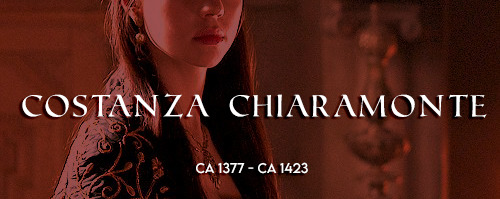
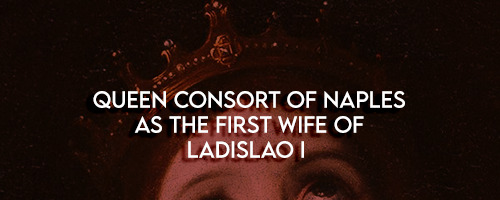


“But it happened that some merchants from Gaeta, who had gone to Sicily to buy grain, spoke in front of the Queen about the riches of Manfredi Chiaramonte, and about the beauty of a daughter of his. Whence the Queen's wandering mind stopped to think to ask for the girl's hand on behalf of her son, the King Ladislao, who was already fourteen [sic] years old.”
in Angelo Di Costanzo, Historia del Regno di Napoli dell'Ill. Signor Angelo di Costanzo, Gentil’huomo e Cavaliere Napolitano, p. 237 [my translation]
Costanza was born around 1377 (probably in Palermo) from the noble and ancient family of Chiaramonte. She was the daughter of Manfredi III Chiramonte, IX Earl of Modica and Duke of Malta, and his wife, Eufemia Ventimiglia. Costanza's father was a powerful man, who, during his lifetime, would hold high profile roles, such as Admiral, Grand Seneschal, Master Justiciar and Regent of the Kingdom for young Queen Maria of Sicily. From her mother side, she was the granddaughter of another former Regent, Francesco II Ventimiglia, Earl of Geraci.
In 1389 Margherita of Durazzo, Regent of the Kingdom of Naples, asked fellow Regent Manfredi Chiaramonte for Costanza's hand on behalf of her son, the twelve years old Ladislao of Anjou-Durazzo. Three years prior, after his father Carlo III had been murdered, Ladislao failed to be recognized by Urban VI as legitimate King of Naples. The Pope had assigned the throne to Louis II of Anjou, whose father had previously (in 1380) been adopted as son and heir by the childless Queen Giovanna I of Anjou-Naples in an attempt to block the rival Anjou-Durazzo's claims to the Neapolitan throne. In 1387 Louis II's troops invaded the Kingdom of Naples, so young Ladislao, alongside his mother, the rest of the family and court, was forced to seek refuge in Gaeta.
If the Chiaramontes' social status benefited from the newly acquired (although wobbly) royal connections, the Anjou-Durazzo made good use of the bride's rich dowry to replenish their worn-out coffers. Their economic situation was so dire, the University of Gaeta had to act as a guarantor and advance the sum of 15 thousand gold florins on behalf of the royal family, which would have been handed to the bride's family in case of non-consummation of the marriage and consequent dissolution of the union. In summer 1389 Costanza then arrived in Gaeta by sea escorted by galleys. These same vessels managed successfully to break the chains which locked Naples' harbour and bring relief to the Durazzo forces besieged in Castelnuovo.
In October of the same year, one of Ladislao' enemies, Urban VI died. Unlike his predecessor, Boniface IX favoured the Durazzos since the Anjou supported the Antipope Clement VII. As also the Chiaramonte backed the newly elected Pontiff, the union between Ladislao and Costanza received Clement's blessing. The marriage between the now recognized King of Naples and the Sicilian noblewoman (they were both 13 years old) finally took place on August 15th 1390 (the marriage settlement probably dated back to September of the previous year). The religious ceremony was immediately followed by a joint crowning ceremony.
This union would prove to be short-lived as Chiaramontes' fortunes were about to change. Costanza's father, Manfredi died in 1391 and was succeeded by his kinsman, Andrea Chiaramonte, X Earl of Modica. That same year, Queen Maria married her second cousin Martino the Younger of Aragon. In the eyes of the majority of the Sicilian nobles, Martino was a stranger (despite being, like his wife, a descendant of Pietro II of Sicily) and his marriage to the Queen could (and would) have led to Sicily fall under a more direct control of the House of Aragon, with the consequent loss of influence of the Sicilian nobility. In the end, Andrea Chiaramonte was abandoned by his allies and found himself alone in trying to contrast the new King consort and his father, the powerful Infante Martino, Duke of Montblanc (and later King of Aragon and Sicily). The Earl of Modica was arrested, charged with treason and beheaded in Palermo, June 1st 1392.
With the decline of her family, the young Queen of Naples' fortunes too deteriorated. The King had now no reason to be still married with the representative of a disgraced household. In May of the same year, Ladislao had travelled to Rome to obtain from the Pope the annulment of the marriage. The official motivation was the minority of the bride and groom. To make things worse, the Queen's mother, Eufemia Ventimiglia, was accused of debauchery and to have become Infante Martino's mistress.
In July 1392, the Pope conceded Ladislao the desired annulment, and the bill of divorce was read publically by the Bishop of Gaeta while the King and Queen were attending mass. The Bishop pulled the wedding ring from Costanza's hand and handed it back to Ladislao.
Three years later, the King married his former wife to one of his vassals, Andrea di Capua, IV Earl of Altavilla (1374-1399). Costanza's modest dowry amounted to 3 thousand ducats. According to tradition, she publically and disdainfully addressed her new husband telling him he could now brag he could call as his concubine his King's wife. Costanza bore Andrea di Capua at least one son, Luigi (1400-1443), who will inherit his father's titles and possessions. Costanza died in 1423 and is currently buried in the Church of the Madonna delle Grazie, in Riccia (n the region of Molise), together with her husband, son and the rest of the di Capua's members.
As for Ladislao, in 1403 he would marry Maria of Lusignan, Princess of Cyprus and Jerusalem, but the new Queen would die the following year. In 1406 he would marry a third and last time, with Maria of Enghien, widow of Raimondo Orsini del Balzo, Prince of Taranto. The King of Naples would die 8 years later without legitimate children and the crown would be inherited by his sister Giovanna II.
Sources
- Salvatore Fodale, COSTANZA Chiaramonte, regina di Napoli in Dizionario Biografico degli Italiani
- Angelo Di Costanzo, Historia del Regno di Napoli dell'Ill. Signor Angelo di Costanzo, Gentil’huomo e Cavaliere Napolitano
- Famiglia di Capua
#history#women#history of women#women in history#historical women#costanza chiaramonte#ladislao i#manfredi iii chiaramonte#chiaramonte#aragonese-spanish sicily#people of sicily#women of sicily#myedit#historyedit
66 notes
·
View notes
Photo
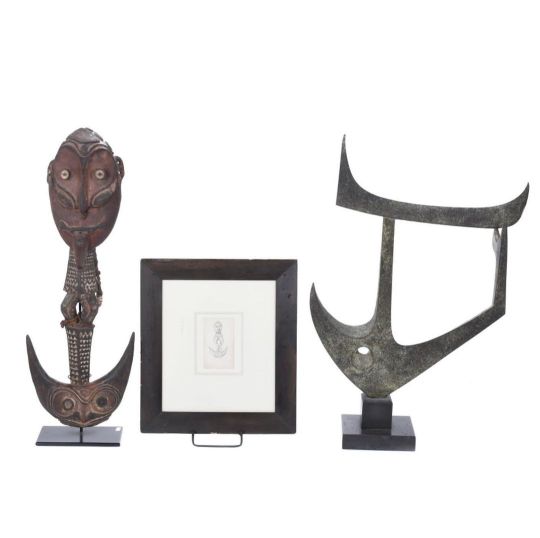
🔍Un lote con una historia muy interesante: - El número 571 de nuestra próxima subasta del 22 de septiembre, tiene un apellido que a todos os sonará: Breton. Pero, por qué encontramos tres piezas? Según nuestra experta en pintura, María Rodríguez, durante la exposición "ORÍGENES", celebrada por la Galería Cyprus Art en Sant Feliu de Boada, Girona, el 31 de julio de 1995, en homenaje al artista primitivo, los artistas participantes recibieron una obra de arte tribal para crear una réplica desde su propia óptica. En el lote que tenemos el placer de presentarles, el artista Eduald Serra creó la escultura "Forma i Espai" a partir de su reinterpretación de un "Samban", o gancho de suspensión. Este tipo de ganchos eran objetos clásicos de la región de Sepik y se utilizaban para proteger las redes o alimentos de los animales o las humedades del suelo. El Samban que presentamos, cuya forma representa una deidad ancestral, fue adquirido en dicha exposición, en la cual participaron artistas de la talla de Eduardo Chillida, Sergio Aguilar, Andreu Alfaro, Frederic Amat, Eduardo Arroyo, Modest Cuixart, Luis Gordillo, Josep Guinovart, Hernández Pijuan o Riera i Aragó. La pieza más importante sin duda es el dibujo del gancho Sepic realizado por André Bretón, adquirido posteriormente. En este sentido lo encontramos en un soporte muy curioso: una tarjeta de visita de un importante galerista parisino, que es casi, un certificado de autenticidad. El cedente de este lote ha querido encarecidamente que estos lotes vayan de la mano, y a nosotros, nos encanta. ¿Y a vosotros/as? - 📌Encuéntralo en el link de la bio (en Subarna) https://www.instagram.com/p/CivFUyVo1xK/?igshid=NGJjMDIxMWI=
1 note
·
View note
Text
Cap 143 : Nuestros Genes Levantinos : Fenicio Cartaginés Cananeo Judío
.
Aquí referencio Publicaciones muy serias. Esto seguramente será corregido y cambiado con el Tiempo. Yo no soy Historiador, Arqueólogo o Genetista. No soy Científico de nada, sinó solo un Aficionado, Diletante, Gomoso, Hobbyst.
.
En el siguiente Mapa ves la Frecuencia del Haplogrupo T que se suele asociar con el Medio Oriente, o sea los Levantinos. Los Fenicios son los mismos Cananeos, llamados así por los Griegos, pero son indistinguibles, los Judíos parecen ser los mismo Cananeos según un Consenso Científico y Genético que se va imponiendo. Los Cartagineses son los mismos Hijos de los Fenicios.
Se piensa que el Haplogrupo T del Cromosoma Y masculino se esparció por el Mediterrano gracias a los Fenicios, Cartagineses, Judíos y a los Arabes que permanecieron en España por muchos Siglos.
.

.
Haplogroup T is one of the most widely dispersed paternal lineages in the world. In Europe, it makes up only 1% of the population on most of the continent, except in Greece, Macedonia and Italy where it exceeds 4%, and in Iberia where it reaches 2.5%, peaking at 10% in Cadiz and over 15% in Ibiza. The maximal worldwide frequency for haplogroup T is observed in East Africa (Eritrea, Ethiopia, Somalia, Kenya, Tanzania) and in the Middle East (especially the South Caucasus, southern Iraq, south-west Iran, Oman and southern Egypt), where it accounts for approximately 5 to 15% of the male lineages.
...................
Ancient civilisations associated with Y-haplogroup T
During the Copper and Bronze Ages haplogroup T would have been an important (though probably not dominant) lineage among ancient peoples such as Sumerians, the Babylonians and the Assyrians.
The higher than average frequencies of haplogroup T in places like Cyprus, Sicily, Tunisia, Ibiza, Andalusia and the northern tip of Morocco suggest that haplogroup T could also have been dispersed around the Mediterranean by the Phoenicians (1200-800 BCE), and that ancient Phoenicia seemingly had a higher incidence of T than Lebanon does today (5%).
.
Fuente : Eupedia - Haplogroup T - Geographic Distribution
https://www.eupedia.com/europe/Haplogroup_T_Y-DNA.shtml?
************************************
.
Distribución del Haplogrupo T (ADN-Y)
Europa: Encontramos la frecuencia más importante en la isla de Quíos (Grecia) con 25%,5? en los sicilianos de Sciacca con 17.9%, en Ibicencos 16.7%, en tiroleses de Stilfs 13.5%, en Cádiz 10.3%, en cretenses de Lasithi 8.7%, en lebaniegos de Liébana 8.1%, en portugueses de Vila Real 7.7%, en serbios 7.4%, en aragoneses 6%, en corsos 6%, en extremeños 6%, en Gotland 5%, en asturianos 5% y menores frecuencias en Italia, Estonia, Grecia, Iberia, Suecia, Francia y poco en Rusia.
Cáucaso: Especialmente en los lezguinos de Daguestán con 28%.6? También en osetios, en Chechenia, Azerbaiyán y Armenia.
Cercano Oriente: En Omán 8%, Irak 7%, Emiratos Árabes Unidos 5%, Líbano 5%, y menores frecuencias Irán, Turquía, Israel, Jordania y Arabia Saudita.
https://es.wikipedia.org/wiki/Haplogrupo_T_(ADN-Y)
.
************************************
Próxima Imagen : Reconstrucción Facial de un Esqueleto de un Cementerio en el Antiguo Cartago, vivió 500 Años antes de Cristo. Es un Hombre de 25 Años y el Examen Genético revela que tiene Ancestros Europeos probablemente Ibéricos.
.

.
Madrid, 25 may (EFE).- Un equipo internacional de científicos ha secuenciado el genoma mitocondrial del "hombre joven de Byrsa" o Ariche, un fenicio fallecido hace 2.500 años y cuyo ADN ha demostrado que sus ancestros procedían de algún lugar de la costa norte del Mediterráneo, probablemente de la península Ibérica.
El "hombre joven de Byrsa" fue descubierto por casualidad hace veinte años durante una excavación en la necrópolis de Byrsa, antigua ciudad de Cartago, y actualmente parte del área metropolitana de Túnez.
Este hombre, también bautizado como Ariche, que significa el hombre deseado, tenía entre 19 y 24 años, era robusto, medía cerca de 1,70 metros y probablemente falleció de forma accidental.
Dado que fue enterrado con gemas, escarabajos, amuletos y otros artículos, los paleontólogos creen que pudo pertenecer a la elite cartaginesa.
Estudio desvela que fenicios de Cartago procedían de costa norte mediterránea
https://www.lavanguardia.com/vida/20160525/402043903638/estudio-desvela-que-fenicios-de-cartago-procedian-de-costa-norte-mediterranea.html
.
************************************
.
Genética Fenicia que dejaron en Iberia
Entre los años 1200 y 539 a. C., los fenicios construyeron un vasto imperio comercial desde su tierra natal levantina a lo largo del sur del Mediterráneo hasta Andalucía. La ciudad más antigua de Iberia es Cádiz, que fue fundada por los fenicios como Gadir o Agadir en 1104 a. Los fenicios también fundaron Almuñécar, Málaga, Cartaya y Huelva, y se establecieron en otras ciudades existentes como Tartessos y Carmona.
Según los haplogrupos encontrados en el Líbano moderno y en sus antiguas colonias, los fenicios parecen haber transportado una mezcla de haplogrupo J2a, J1, E1b1b, G, R1b-M269 / L23, T, L, R1b-V88, R2. y Q1b, aproximadamente en ese orden de frecuencia. No es fácil evaluar el porcentaje de linajes ibéricos modernos de origen fenicio porque muchos otros pueblos trajeron haplogrupos similares. Los linajes fenicios más singulares, que normalmente no se encontraban entre los antiguos griegos y romanos, son Q1b, R1b-V88 y R2. Y, de hecho, todos ellos se han encontrado, principalmente en Portugal y en el suroeste de Andalucía, pero solo a frecuencias mínimas (menos del 0,5%).
La isla de Ibiza fue otra importante colonia fenicia, que tiene la particularidad de haber quedado aislada durante la mayor parte de su historia posterior. Por lo tanto, es probable que tenga más linajes fenicios que el promedio. Ese es probablemente el caso como Adams et al. (2008) encontraron el 17% de haplogrupo T en Ibiza, con mucho el porcentaje más alto en Europa para el linaje del Medio Oriente, pero también 13% de haplogrupo G (más que en cualquier otro lugar en Iberia) y 4% de E-M123, la variedad levantina de E1b1b.
No es sorprendente que el segundo porcentaje más alto de haplogrupo T identificado en Iberia se encuentre en Cádiz (10%). Al igual que el haplogrupo T, E-M123 se encuentra principalmente en Murcia, Andalucía, Extremadura y Portugal, lo que sugiere que aquí es donde los fenicios tuvieron el mayor impacto genético. No es sorprendente que los haplogrupos J1 y J2a también tengan un pico en estas regiones.
.
Fuente : Eupedia
Historia genética de los españoles y portugueses
https://www.eupedia.com/genetics/historia_genetica_de_iberia.shtml?
.
************************************
.
Siguiente Imagen : El Haplogrupo E-M123 puede haber sigo transportado por los Fenicios durante su Epoca gloriosa en el Mediterraneo. Ver que mas arriba en esta Página se dice “Al igual que el haplogrupo T, E-M123 se encuentra principalmente en Murcia, Andalucía, Extremadura y Portugal.”
.
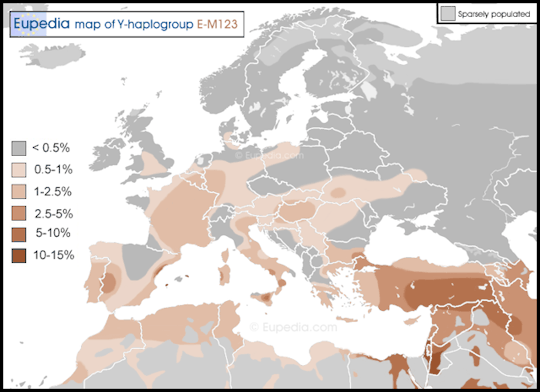
.
The hotspot in Spanish Extremadura may have something to do with the major Roman colony of Merida. But that alone wouldn't explain the overall higher frequency in western Iberia, mimicking those of E-M81 and E-V13. Western Iberia is really special in having a lot of the three main E1b1b subclades, despite the fact that the three have very different distributions.
.
Fuente : Eupèdia - Thread: New distribution map of haplogroup E-M123
https://www.eupedia.com/forum/threads/29108-New-distribution-map-of-haplogroup-E-M123
.
************************************
.

.
Quite a few ancient Mediterranean and Middle Eastern civilisations flourished in territories where J2 lineages were preponderant. This is the case of the Hattians, the Hurrians, the Etruscans, the Minoans, the Greeks, the Phoenicians (and their Carthaginian offshoot), the Israelites, and to a lower extent also the Romans, the Assyrians and the Persians. All the great seafaring civilisations from the middle Bronze Age to the Iron Age were dominated by J2 men.
..............
The Phoenicians, Jews, Greeks and Romans all contributed to the presence of J2a in Iberia. The particularly strong frequency of J2a and other Near Eastern haplogroups (J1, E1b1b, T) in the south of the Iberian peninsula, suggest that the Phoenicians and the Carthaginians played a more decisive role than other peoples. This makes sense considering that they were the first to arrive, founded the greatest number of cities (including Gadir/Cadiz, Iberia's oldest city), and their settlements match almost exactly the zone where J2 is found at a higher frequency in southern Andalusia.
.
Fuente : Eupedia - Haplogroup J2 (Y-DNA)
https://www.eupedia.com/europe/Haplogroup_J2_Y-DNA.shtml?
.
************************************
.

.
All three branches of J1-L858 (S640, YSC76 and FGC11) are found in Europe, principally in Spain, Italy, central and eastern Europe. Their relatively recent time of divergence with their Middle Eastern cousins (Late Bronze Age to Iron Age) suggests that they would have arrived with the Phoenicians (Sicily, Sardinia, Spain), and later in greater numbers with the Jewish diaspora. Spain and Portugal have the highest percentage of FGC12 in Europe, but this amounts to about 12% of J1 lineages, i.e. less than 0.5% of the population, suggesting that the Arabs had a much smaller genetic impact on the Iberian population than the Jews and the Phoenicians.
.
Fuente : Eupedia - Haplogroup J1 (Y-DNA)
https://www.eupedia.com/europe/Haplogroup_J1_Y-DNA.shtml
.
0 notes
Text
Samowola budowlana musi kosztować
Brytyjczycy się nie patyczkują! Nakazali rozbiórkę i nałożyli gigantyczne grzywny za samowolę budowlaną na swoim terenie na Cyprze.
Brytyjczycy się nie patyczkują! Nakazali rozbiórkę i nałożyli gigantyczne grzywny za samowolę budowlaną. Gdyby ta sytuacja wydarzyła się na terytorium Cypru, prawdopodobnie nikomu nic by się nie stało a samowola budowlana dalej stałaby na swoim miejscu. A po czasie, jakiś znajomy urzędnik uprawomocniłby nielegalne działanie. Ta historia wydarzyła się jednak na terytorium zarządzanym przez…
0 notes